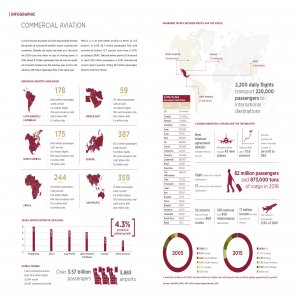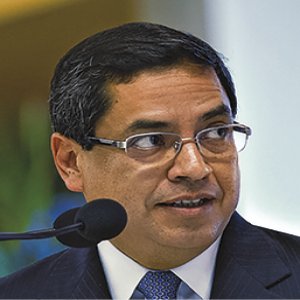Safety is the no. 1 Priority

STORY INLINE POST
Q: What is ALTA’s role in the development of aviation in Latin America?
A: While airlines compete for market share, there are topics which concern them all. ALTA is a platform for all Latin American and Caribbean airlines to discuss these topics and to share processes, including safety, maintenance, credit card fraud, training and consumer regulations. We created a group that unites aircraft manufacturers, operators and regulators to address safety issues periodically.
One of the main priorities for our airlines is safety. Ten years ago, Latin America competed with Africa as one of the most unsafe regions for aviation. Following a concerted effort by local airlines, Latin America is now one of the safest regions with zero fatal accidents by our airlines over several years. The industry has grown and changed enormously, doubling in passengers and aircraft. From having the oldest fleet in the world, Latin America now has one of the most modern. This fleet renewal has also brought about maintenance process updates.
Q: How does ALTA promote the unification of regulations across Latin America?
A: One of ALTA’s priorities is to generate a single set of efficient regulations. We are incentivizing governments to analyze the entire region before making decisions and to consider ICAO’s recommendations. Sadly, many are making decisions based on local needs and interests. This generates complexity and additional costs for operators.
MRO services require several operating permits from the government where the workshop is based, the Federal Aviation Administration (FAA), the European Aviation Safety Agency (EASA) and the client airline’s home country. Service providers therefore spend a lot of time generating and submitting paperwork. In an ideal scenario, these workshops would only need permits from a single country to work legally for all airlines operating in Latin America. Large connection hubs, such as Singapore and Dubai, have followed this principle of simplification by generating clear policies for operations, crews and consumers.
Q: What measures has the Mexican government taken to encourage civil aviation and collaborate with ALTA?
A: Mexico’s regulations are evolving. State policies to promote the sector must go beyond six-year presidential periods. The country started by eliminating the visa requirement for Colombians. This led Mexico-Colombia air traffic to increase by over 40 percent. This move was later copied by the Dominican Republic as it lost its competitive advantage. Good governmental policies increase air traffic, lower fares and stimulate economic growth.
We are also working with Navigation Services for Mexican Airspace (SENEAM) to generate an appropriate air space management design that will satisfy existing and future demand. This is particularly challenging in light of the construction of a new airport in Mexico City, because its six runways will make it necessary to redesign Mexico City’s air space and that of neighboring cities.
Q: What major aviation trends stand out in Latin America?
A: Consolidation, low-cost carriers, partnerships, alliances and progress on the environmental front are all key trends in Latin American and Caribbean aviation. The consolidation of major players, the arrival and growth of low-cost airlines and the generation of international partnerships stood out in 2016 and 2017. Aviation follows economies of scale. Airlines have fixed costs per airplane so to optimize spending, we must increase the number of hours our aircraft are flying and the number of passengers and cargo per flight. The region will continue to see strong passenger growth in the next decade that requires a significant influx of new ideas, outside-the-box solutions and investments to accommodate these additional travelers.
Latin America needs to strengthen its MRO service offering. Mexicana MRO and the aerospace cluster in Queretaro in particular are strengthening Mexico’s capabilities for these services. Aeroman in El Salvador and Coopesa in Costa Rica are helping boost Latin American MRO growth. We have sufficient talent available for these service providers to expand significantly if we ensure proper training and support strategies. The training process of an aviation mechanic can take several years but it opens doors to economic development and opportunities for all involved.
Q: How is aviation contributing to economic development in Latin America?
A: Aviation is a vital engine driving economic connectivity, growth and development in communities throughout the region. In many countries, 80 percent of tourists arrive by airplane but in Latin America, aviation was historically perceived as a luxury product. This is still true if evaluated in terms of taxes but aviation is the public transport system of the 21st century. It is the backbone of tourism and an essential tool for commerce. In 2015, the region’s air transport industry generated 800,000 direct jobs and over 5 million indirect jobs. Without aviation, many communities would be unconnected, vaccines and medicines would not reach patients and governments would not have communication with part of their population.
Q: What challenges are Latin American airlines facing?
A: The lack of harmonized regulations across the region is challenging. Latin America is home to approximately 600 million people and treating every country as an entirely separate market is costly and inefficient in such a globalized industry. The region’s consumer regulations are extremely complicated, costly, inefficient and lag behind other areas of the world. There are over 45 different consumer regulations in our region while the European Union has a single regulation for roughly the same number of people.
The aviation sector in Latin America began with small, often state-owned airlines. Many of these have merged into bigger conglomerates Unfortunately, these international companies are still operating under differing and outdated local regulations.
Airlines also face high and excessive airport charges. Airlines have lowered average fares in the region by 30-40 percent, and doubled or even tripled the number of domestic and international passengers. But airport taxes and fees continue to rise. We lower fares, incorporate new technologies, increase productivity, lower fuel consumption and lower costs, but taxes and fees are raised again. This is unsustainable and in some airports, passengers pay more in airport charges than for the flight itself. This is disproportionate when operating an airport is not as risky or complex as running an airline. The net effect is decreased competitiveness.























